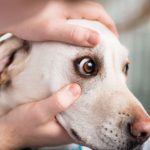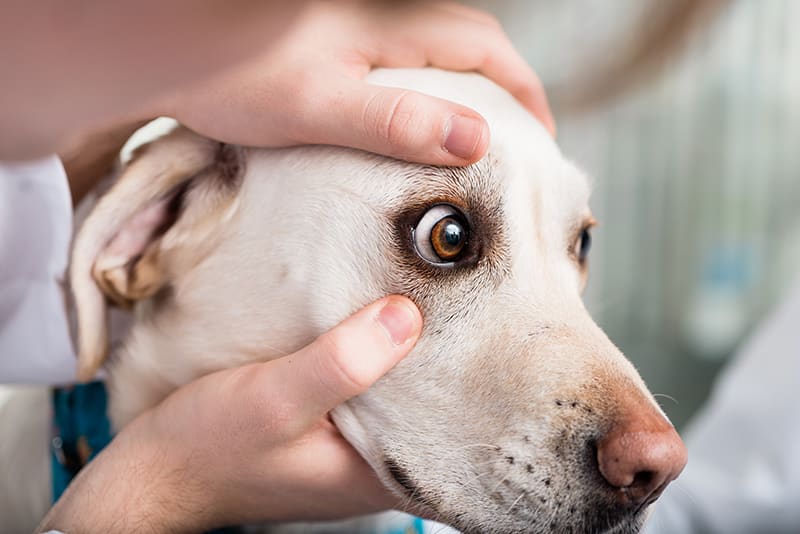Eye disorders in dogs can be easily recognized if you know what signs to look for. Always check that your dog’s eyes are open and bright. Many eye problems quickly become obvious, but some disorders affecting the inside of the eye may not be suspected until the dog’s sight is affected.
Obvious Signs of a Problem
- Eyelids fully or partially closed
- Watery discharge
- Sticky, yellow-green discharge
- Pawing at eyes
- Increased blink rate
- Reduced vision, bumping into objects
- Red eye
- Swollen eye or eyelids
Conjunctivitis
Unlike the highly infectious eye disorder that affects people, conjunctivitis in dogs simply means inflammation of the conjunctiva, the layer covering the front of the eyeball.
The most obvious sign is reddening inside the lower eyelid. There may be a discharge, initially clear but becoming white or green if an infection develops. Your dog may blink rapidly because of pain.
The inflammation is sometimes due to an allergy to pollen, but the most common causes of conjunctivitis in one eye are foreign bodies, such as a grass awn or a speck of dirt or sand. Your vet may numb the front of the eye with local anesthetic drops to make an examination.
Fluorescein dye applied to the eye may reveal an injury to the cornea such as a scratch. There may be a film over the eye due to an inflamed cornea, as well as conjunctivitis. Prompt attention is needed as the iris can be affected too, with painful spasm of the pupil.
Your dog may be prescribed pain relief and oral antibiotics as well as eye drops, and will need careful monitoring. For allergy-related conjunctivitis, steroid eye drops help to reduce inflammation. Your dog may need an Elizabethan collar to stop him from rubbing his eye.
Entropion and Ectropion
The  eyelids have a protective role but if they roll inward, a condition called entropion, the eyelashes rub against the front of the eye causing conjunctivitis and corneal ulceration. Entropion is usually congenital, but can develop after injury or as a result of chronic conjunctivitis.
eyelids have a protective role but if they roll inward, a condition called entropion, the eyelashes rub against the front of the eye causing conjunctivitis and corneal ulceration. Entropion is usually congenital, but can develop after injury or as a result of chronic conjunctivitis.
The dog will blink more often and rub at his eyes, resulting in infection and a thick discharge. Entropion is corrected by surgery, although there is a risk of over-correction and ectropion, an outward rolling of the eyelid that exposes the eye to potential injury.
Ectropion can also occur naturally, congenitally, or in old age. Usually, only extreme cases are corrected. Some breeds, such as the English Bulldog and Cocker Spaniel, are prone to a combination of entropion and ectropion.
Cataract
In this disorder, the transparent lens of the eye, which directs light to the retina, becomes opaque, impairing sight. Cataracts can be hereditary or many form in response to retinal disease, glaucoma, or diabetes.
Senile cataracts may develop in old dogs. Cataracts can be removed surgically, usually only if the retina is intact so that the dog can see afterward.
Glaucoma
Raised pressure within the eyeball, known as glaucoma, causes pain and ultimately loss of vision. The condition can be treated but needs early diagnosis to avoid blindness. Glaucoma is an inherited problem in some breeds, including Beagles and Bassett Hounds.
Dry Eye
Lack of tear production to lubricate the eyes results in dryness and a thick discharge due to infection. Dry eye is diagnosed by a painless test and treated with eye drops or surgery. It is an inherited problem in some breeds, for example, the West Highland White Terrier.
Horner’s Syndrome
This set of symptoms usually affects one eye only, with a sunken eyeball, drooping of the upper eyelid, prominence of the third eyelid at the inner corner of the eye, and constriction of the pupil. The cause is often unknown and it resolves itself, but your dog should be examined by a vet for possible underlying health problems.
How to Apply Eye Drops
- Supporting your dog’s head, gently pull down on the lower eyelid and raise the upper lid.
- Hold the dropper between your thumb and forefinger and squeeze the drops onto the front of the eye.
- After applying the drops, gently hold your dog’s eyelids closed for a few seconds.

